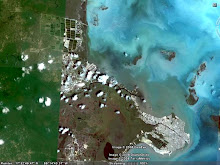
I'll try to make this brief and brilliant.
This is the control structure (dam) for a sedimentation pond. Shrimp farms use sedimentation ponds to trap water and let organic and inorganic particles "settle" to the bottom so they won't enter natural water ways. They are a good way to remove nutrients and they are where we plan to deploy the Inventor's Club invention to remove nutrients.
The control structure generally looks like some variation of the object above, with removable boards slid into slots in a concrete post holding back the water and creating the dam.
The water comes into the pond looking like this...

And yesterday the water was that much clearer still, because we tried a little experiment with Aquamats. Inar Cayetano, the new environmental coordinator at Aquamar shrimp farm and myself, placed an Aquamat at the outflow of a control structure...and in SIXTEEN HOURS...on a completely clean Aquamat, we got THIS to grow....
I'll try to post numbers soon.
While you are thinking about your designs, keep this little experiment in mind. This kind of yeild opens up some very efficient design possibilities.






This experiment evolved from thoughts I had been having about straining the effluent water vs. using substrates in static water, and an observation Elizabeth Allen made to me while we were looking at the Uni model system. Elizabeth pointed out that the best yeilds of algae there were on the filter floss in the flow through filter. Everything else was very slow growing. So...I stuck an aquamat in a control structure and voila. It's trapping the material rather than having it grow there. Now you have a LOT of biomass to work with to make your nutrient removal device cost effective. This yeild is far beyond anything Aquamats have been able to do in other settings. Testing it now to see what's in it.
ReplyDeleteThis looks really promising!!
ReplyDeleteThis morning I went out and installed the belt into a prototype in a creek. I took video and pictures of that so once our video man, Tej, loads the pictures on the computer, it will be posted. We are having a meeting tomorrow, so I think that be posted by tomorrow.
-Elizabeth
I was really surprised the first time I looked at this. I guess that when I imagined the water, I imagined tiny particles that you can't see and assumed that the water must be clear. I guess that I forgot that when the there are tons of tiny particles suspended, the solvent tends to turn colors too. It's really cool to see the huge difference in the water going in and the water going out. This will definitely help with our efficiency issue.
ReplyDelete-Amy
Elizabeth Russell and I (Elizabeth Allen) are going to try to build a larger belt structure that will be implemented in the stream leading towards the control structure. We tried harvesting the prototype we have here with nail brushes, which worked to some extent, but we were surprised to see that the growth had disappeared since we had taken the pictures. It seemed like the algae was soggy. However, the growth we did retrieve from the belt was put into a small bucket of water and the algae floated to the top. We plan on isolating the algae with a centrifuge and look at it under the microscope to ensure that we are growing the algae we want.
ReplyDeleteWe need to know the dimensions of the control structure in order to try to build something to complement the flowing water. However, we have come up with a few design ideas that we sketched out and will discuss with you (Mr. Smith) on Monday.
-Elizabeth Russell and Allen